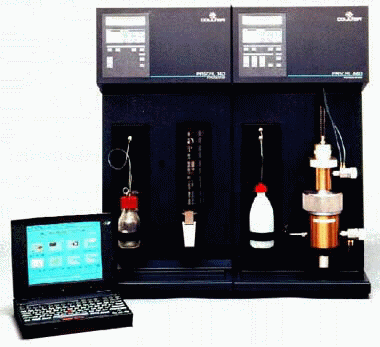|
The mercury porosimetry technique is
one of the most useful methods to investigate the porous structure
of solid samples in a quantitative way.
It provides reliable information about
pore size/volume distribution, particle size distribution, bulk
density and specific surface for most porous solids regardless
of their nature and shape.
Pressurization by Automatic Speed-up
and Continuous Adjustment Logic, or, in short Pascal, is a new
operating principle offered by Coulter Corporation and used in
the new generation of automatic mercury porosimeters described
herein.
Pascal self-optimizes analysis parameters
Mercury porosimetry analysis is based
on the measure of the intrusion of mercury into the pores of the
sample at various pressures. The pressurization procedure is
critical to the accuracy and speed of the analysis because a certain
equilibrium time is required for the mercury to fill the pore
at each pressure. This depends on the external pore access diameter
and on the shape and complexity of the pore. In principle it
is impossible to know which pressure rate is the most suitable
for the sample as the pore size range and pore shape in difference
solid samples are unknown. An excessively high pressurization
rate gives wrong results because the pores are not completely
filled at the corresponding pressure, whereas a low pressurization
rate wastes valuable laboratory time. The solution is Pascal.
Pascal fits your sample
The Pascal method automatically determines
the correct pressurization speed according to the presence of
pores and to the actual mercury penetration rate thereby eliminating
dead times during the analysis. This operation is performed in
the same way at any pressure.
The Pascal Method combines all the benefits
in one system:
- optimum information quality at every
speed.
- highest resolution
- minimum analysis time.
Pascal does it faster than ever!
The pressurization starts "softly"
and in absence of penetration increases quickly to the maximum
predetermined speed. Nine (9) different speed characteristics
are available covering different application fields and analytical
purposes and making it possible to
choose a balance between the scientific
quality of the information and the total run time. When mercury
intrusion is detected by the mercury level detector, the pressurization
immediately slows down without stopping completely. The acceleration
and deceleration of the pumping system are balanced to assure
the necessary equilibrium time for full penetration into the pores
with the same access size while eliminating dead times.
- The Pascal method of pressurization
- Decreases run times by up to 30% without
sacrificing the reliability of
the curves and does not require any
prior knowledge about the sample characteristics.
- Extremely high resolution
- Pascal
units can provide curves with up to 2500 data points depending on the selected speed and
sample nature. At this incredibly high resolution the data
points on the curve form a continuous line.
- Separately selectable speed range
to increase and decrease pressure
- Nine speed ranges are selectable so
that both sophisticated researchers, who don't want to miss anything and
those who are in a hurry, as in the case of quality control, can be satisfied.
Decrease speed ranges can be selected independently of increase speed ranges
to better define the extrusion curve and minimize instrumental hysteresis.
- Three models cover practically
any application
- The three Pascal Models 140, 240 and 440 are modular and complement each other to cover the full range
of requirements. They can accept and measure virtually any kind of porous
materials. According to the applications they can be used individually or together.
When the sample to be analyzed show a well defined porosity
one unit is generally sufficient. You don't need to buy more
than you need.
- On-Board microprocessor and memory
data buffer for stand-alone operation
- The on-board microprocessor controls all the instrument functions
and collects the experimental data storing
them in a memory buffer, therefore a PC is not required to run
the Pascal but only for data elaboration. On the other hand the
whole analysis can be programmed and controlled form a PC, which can be
disconnected at any time during the analysis freeing it for other tasks.
The operator can verify the instrument status and can transfer the experimental
data to the PC to verify the analysis results at any time.
- Single electrode for all dilatometers
- A
single electrode cup is easily fitted on the stem of all dilatometers.
The volume detection system can be easily checked by the operator
himself to comply with the latest regulations
in terms of quality. An additional advantage of this design is represented
by its compatibility with full automated calibration operations.
- One data station - four instruments
via multi RS232 link
- The
instruments are connected to the PC through a standard serial RS232 port. A single data station can
control up to four instruments from a serial port. Thus a complete lab
can be realized minimizing costs and bench space.
- Choice of operation via control
panel or PC
- Both the analysis and the instrument
can be programmed and controlled in real time either from an easy-to-use
control panel with liquid crystal display or from the Digital Status
Display (DSD) generated on a PC screen. Thus the instruments can be operated
even if they are not in the same room as the data station, as often
occurs in QC labs.
- Automatic porosimeter calibration
- A special calibration kit is available as an option to verify the
quality of the data produced by the porosimeters and
to confirm that they comply with the requirements of the quality norms.
| 








